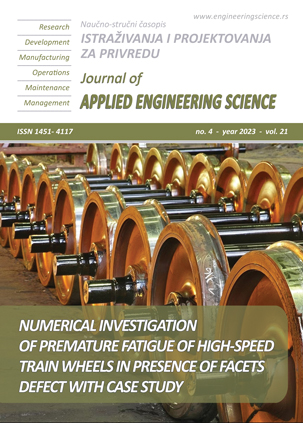NUMERICAL STUDY THE EFFECT OF AIR BARRIERS HEIGHT INSIDE THE AIR CONDITIONING DUCTING TO SATISFY THE REGULATION OF INDONESIA MINISTER OF TRANSPORTATION NUMBER 69 OF 2019
Abstract
The Indonesian smart hybrid light train is a train under development by the government and will operate in Makassar-Parepare, Indonesia track. The authors conducted a numerical study on CFD to investigate the air flow distribution inside the air conditioning ducting and the air velocity and air temperature distribution on Motor Engine and Compartment (MEC) car to achieve the passenger comfort criteria based on the regulation standard of Indonesia Minister of Transportation Number 69 of 2019. This study was conducted by simulating 5 variations of air barriers height inside the supply ducts. The input of air into the ducting has the parameters of mass flow rate, static temperature, static pressure, and density with the values of 1 kg/s, 20 °C, 1 atm, and 1.2 kg/m3, respectively. The simulation results show that variation E is the best design which generated the average air velocity and air temperature distribution in the executive passenger cabin with the values of 0.25 m/s and 21.91 °C, respectively. Meanwhile, the other 4 variations did not satisfy the standard. The results also show that the ducting geometry can accommodate the air temperature difference on the MEC car that does not exceed 1.5 °C and the air supply is sufficient from the air conditioner unit to the driver room.
References
Samah, H., Banna, M. (2009). Performance Analysis of Thermal Insulation Screens used for Classic Roofs in Hot-Humid Tropics. International Energy Journal, vol. 10, 255–266.
Ratanachotinun, J., Pairojn, P. (2014). Feasibility Study of Glass Solar Chimney Wall for Tropical Area, Case Study: Bangkok, Thailand. International Energy Journal, vol. 14, 95–106.
Peng, Y., et al. (2022). Passenger overall comfort in high-speed railway environments based on EEG: Assessment and degradation mechanism. Build Environ, vol. 210, 1–10, DOI: 10.1016/j.buildenv.2021.108711.
Rugh, J., Bharathan, D. (2005). Predicting Human Thermal Comfort in Automobiles. Vehicle Thermal Management Systems Conference and Exhibition 2005, p. 1–9, DOI: https://doi.org/10.4271/2005-01-2008.
Yang, A., et al. (2017). Numerical study on aerodynamic characteristics of high-speed trains with considering thermal-flow coupling effects. Journal of Vibroengineering, vol. 19, no. 7, 5606–5626, DOI: 10.21595/jve.2017.18778.
Selamat, H., Hanif, M., Sharif, Z., Attaran, S., Sakri, F., Razak, M. (2020). Review on HVAC System Optimization Towards Energy Saving Building Operation. International Energy Journal, vol. 20, 345–358.
Hesser, K., Widdowson, J. (2016). Guideline for the Design and Application of Heating, Ventilation, and Air-Conditioning Equipment for Rail Passenger Vehicles. ASHRAE, Atlanta.
Menteri Perhubungan RI, Kementerian Perhubungan Republik Indonesia. Peraturan Menteri Perhubungan Republik Indonesia Nomor PM 69 Tahun 2019 Tentang Standar Spesifikasi Teknis Kereta Api Kecepatan Tinggi, from https://djka.dephub.go.id/uploads/202207/PM_69_TAHUN_2019.pdf, accessed on 2023-05-01.
ANSYS. (2010). ANSYS Fluent Theory Guide, 13th ed. ANSYS Inc., Canonsburg.
Ranjan, R., Paswan, M., Prasad, N. (2017). CFD Based Analysis of a Solar Air Heater Having Isosceles Right Triangle Rib Roughness on the Absorber Plate. International Energy Journal, vol. 17, 57–74.
Samah, H., Tiwari, G., Nougblega, Y. (2020). Cool and Green Roofs as Techniques to Overcome Heating in Building and its Surroundings under Warm Climate. International Energy Journal, vol. 20, 359–372.
Menter, F., Sechner, R., Matyushenko, A. (2021). Best Practice: RANS Turbulence Modeling in Ansys CFD, 1st ed. ANSYS Inc., United States of America.
Khan, I., Baruah, M., Dewan, A., Mahanta, P. (2009). Computational Investigation of Energy Efficient Pin Fin Cross Section for a Compact Heat Exchanger. International Energy Journal, vol. 10, 233–246.
Incropera, F. (2011). Fundamentals of Heat and Mass Transfer, 7th ed. John Wiley & Sons Inc., Jefferson City.
Yusra, A., Haryanto, I., Jamari, D. (2008). Analisa Kontak Elastis Antar Hemispheres Menggunakan Metode Elemen Hingga. Rotasi, vol. 10, 3–7.

